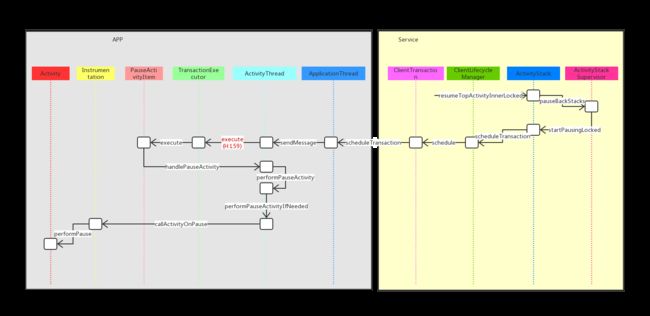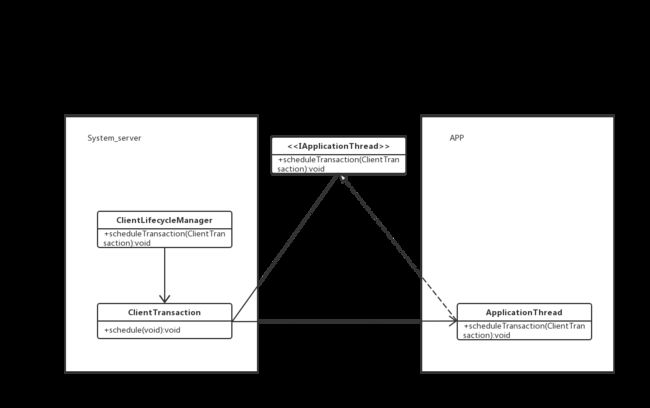前两篇的内容在这里。
Activity启动源码分析--总篇
Activity启动源码分析--预启动过程(1)
1.目的
这篇的话,会涉及到从Service到Client的通信,可以看到跨进程通信里,google的架构设计方式。
看代码前先放图:
2.源码
上一篇讲到,预启动的最后两步,倒数第二部是将当前显示的Activity做pause操作。调用到了mStackSupervisor.pauseBackStacks(userLeaving, next, false)。
ActivityStackSupervisor
/**
* Pause all activities in either all of the stacks or just the back stacks.
* @param userLeaving Passed to pauseActivity() to indicate whether to call onUserLeaving().
* @param resuming The resuming activity.
* @param dontWait The resuming activity isn't going to wait for all activities to be paused
* before resuming.
* @return true if any activity was paused as a result of this call.
*/
boolean pauseBackStacks(boolean userLeaving, ActivityRecord resuming, boolean dontWait) {
boolean someActivityPaused = false;
for (int displayNdx = mActivityDisplays.size() - 1; displayNdx >= 0; --displayNdx) {
final ActivityDisplay display = mActivityDisplays.valueAt(displayNdx);
for (int stackNdx = display.getChildCount() - 1; stackNdx >= 0; --stackNdx) {
final ActivityStack stack = display.getChildAt(stackNdx);
if (!isFocusedStack(stack) && stack.getResumedActivity() != null) {
if (DEBUG_STATES) Slog.d(TAG_STATES, "pauseBackStacks: stack=" + stack +
" mResumedActivity=" + stack.getResumedActivity());
someActivityPaused |= stack.startPausingLocked(userLeaving, false, resuming,
dontWait);
}
}
}
return someActivityPaused;
}
它这边是直接调用了ActivityStack的startPausingLocked方法。
ActivityStack
final boolean startPausingLocked(boolean userLeaving, boolean uiSleeping,
ActivityRecord resuming, boolean pauseImmediately) {
...
if (prev.app != null && prev.app.thread != null) {
if (DEBUG_PAUSE) Slog.v(TAG_PAUSE, "Enqueueing pending pause: " + prev);
try {
EventLogTags.writeAmPauseActivity(prev.userId, System.identityHashCode(prev),
prev.shortComponentName, "userLeaving=" + userLeaving);
mService.updateUsageStats(prev, false);
//mService是一个ActivityManagerService对象,它的getLifecycleManager方法返回一个ActivityManagerService对象。
mService.getLifecycleManager().scheduleTransaction(prev.app.thread, prev.appToken,
PauseActivityItem.obtain(prev.finishing, userLeaving,
prev.configChangeFlags, pauseImmediately));
} catch (Exception e) {
// Ignore exception, if process died other code will cleanup.
Slog.w(TAG, "Exception thrown during pause", e);
mPausingActivity = null;
mLastPausedActivity = null;
mLastNoHistoryActivity = null;
}
} else {
mPausingActivity = null;
mLastPausedActivity = null;
mLastNoHistoryActivity = null;
}
// If we are not going to sleep, we want to ensure the device is
// awake until the next activity is started.
if (!uiSleeping && !mService.isSleepingOrShuttingDownLocked()) {
mStackSupervisor.acquireLaunchWakelock();
}
if (mPausingActivity != null) {
// Have the window manager pause its key dispatching until the new
// activity has started. If we're pausing the activity just because
// the screen is being turned off and the UI is sleeping, don't interrupt
// key dispatch; the same activity will pick it up again on wakeup.
if (!uiSleeping) {
prev.pauseKeyDispatchingLocked();
} else if (DEBUG_PAUSE) {
Slog.v(TAG_PAUSE, "Key dispatch not paused for screen off");
}
if (pauseImmediately) {
// If the caller said they don't want to wait for the pause, then complete
// the pause now.
completePauseLocked(false, resuming);
return false;
} else {
schedulePauseTimeout(prev);
return true;
}
} else {
// This activity failed to schedule the
// pause, so just treat it as being paused now.
if (DEBUG_PAUSE) Slog.v(TAG_PAUSE, "Activity not running, resuming next.");
if (resuming == null) {
mStackSupervisor.resumeFocusedStackTopActivityLocked();
}
return false;
}
}
ClientLifecycleManager
//从上面传来了一个PauseActivityItem,它是ActivityLifecycleItem的子类
void scheduleTransaction(@NonNull IApplicationThread client, @NonNull IBinder activityToken,
@NonNull ActivityLifecycleItem stateRequest) throws RemoteException {
final ClientTransaction clientTransaction = transactionWithState(client, activityToken,
stateRequest);
scheduleTransaction(clientTransaction);
}
//将从上面传来的PauseActivityItem封装成了ClientTransaction
private static ClientTransaction transactionWithState(@NonNull IApplicationThread client,
@NonNull IBinder activityToken, @NonNull ActivityLifecycleItem stateRequest) {
final ClientTransaction clientTransaction = ClientTransaction.obtain(client, activityToken);
clientTransaction.setLifecycleStateRequest(stateRequest);
return clientTransaction;
}
//这里通过binder的方式,让Client执行上面的ClientTransaction
void scheduleTransaction(ClientTransaction transaction) throws RemoteException {
final IApplicationThread client = transaction.getClient();
transaction.schedule();
if (!(client instanceof Binder)) {
// If client is not an instance of Binder - it's a remote call and at this point it is
// safe to recycle the object. All objects used for local calls will be recycled after
// the transaction is executed on client in ActivityThread.
transaction.recycle();
}
}
ClientTransaction
public void schedule() throws RemoteException {
mClient.scheduleTransaction(this);
}
这里的话,可以放一下总篇里总结的调用图。
其实从上面那一步,可以看出,已经从System_server进程回到了app进程。那么app对应的IApplicationThread的实体类,就是ApplicationThread。
ApplicationThread
public void scheduleTransaction(ClientTransaction transaction) throws RemoteException {
ActivityThread.this.scheduleTransaction(transaction);
}
ActivityThread执行了scheduleTransaction方法。但是ActivityThread里没有scheduleTransaction的实现方法。那我们可以从它的父类ClientTransactionHandler里,找到这个方法的内容。
ClientTransactionHandler
/** Prepare and schedule transaction for execution. */
void scheduleTransaction(ClientTransaction transaction) {
transaction.preExecute(this);
sendMessage(ActivityThread.H.EXECUTE_TRANSACTION, transaction);
}
abstract void sendMessage(int what, Object obj);
sendMessage的实现方法又需要回到ActivityThread。
ActivityThread
private void sendMessage(int what, Object obj, int arg1, int arg2, boolean async) {
if (DEBUG_MESSAGES) Slog.v(
TAG, "SCHEDULE " + what + " " + mH.codeToString(what)
+ ": " + arg1 + " / " + obj);
Message msg = Message.obtain();
msg.what = what;
msg.obj = obj;
msg.arg1 = arg1;
msg.arg2 = arg2;
if (async) {
msg.setAsynchronous(true);
}
mH.sendMessage(msg);
}
mH是ActivityThread里的H类型的成员变量。mH可是一个神奇的Handler,这个可以之后详讲。
class H extends Handler {
public static final int EXECUTE_TRANSACTION = 159;
case EXECUTE_TRANSACTION:
final ClientTransaction transaction = (ClientTransaction) msg.obj;
mTransactionExecutor.execute(transaction);
if (isSystem()) {
// Client transactions inside system process are recycled on the client side
// instead of ClientLifecycleManager to avoid being cleared before this
// message is handled.
transaction.recycle();
}
// TODO(lifecycler): Recycle locally scheduled transactions.
break;
}
TransactionExecutor
/**
* Resolve transaction.
* First all callbacks will be executed in the order they appear in the list. If a callback
* requires a certain pre- or post-execution state, the client will be transitioned accordingly.
* Then the client will cycle to the final lifecycle state if provided. Otherwise, it will
* either remain in the initial state, or last state needed by a callback.
*/
public void execute(ClientTransaction transaction) {
final IBinder token = transaction.getActivityToken();
log("Start resolving transaction for client: " + mTransactionHandler + ", token: " + token);
//这里就执行Service传来的ClientTransaction里的callback。从前面看,pause时没有设置这个
executeCallbacks(transaction);
//这里就执行Service传来的ClientTransaction里的stateRequest。自然就是上面传来的PauseActivityItem
executeLifecycleState(transaction);
mPendingActions.clear();
log("End resolving transaction");
}
/** Cycle through all states requested by callbacks and execute them at proper times. */
@VisibleForTesting
public void executeCallbacks(ClientTransaction transaction) {
final List callbacks = transaction.getCallbacks();
if (callbacks == null) {
// No callbacks to execute, return early.
return;
}
log("Resolving callbacks");
final IBinder token = transaction.getActivityToken();
ActivityClientRecord r = mTransactionHandler.getActivityClient(token);
// In case when post-execution state of the last callback matches the final state requested
// for the activity in this transaction, we won't do the last transition here and do it when
// moving to final state instead (because it may contain additional parameters from server).
final ActivityLifecycleItem finalStateRequest = transaction.getLifecycleStateRequest();
final int finalState = finalStateRequest != null ? finalStateRequest.getTargetState()
: UNDEFINED;
// Index of the last callback that requests some post-execution state.
final int lastCallbackRequestingState = lastCallbackRequestingState(transaction);
final int size = callbacks.size();
for (int i = 0; i < size; ++i) {
final ClientTransactionItem item = callbacks.get(i);
log("Resolving callback: " + item);
final int postExecutionState = item.getPostExecutionState();
final int closestPreExecutionState = mHelper.getClosestPreExecutionState(r,
item.getPostExecutionState());
if (closestPreExecutionState != UNDEFINED) {
cycleToPath(r, closestPreExecutionState);
}
item.execute(mTransactionHandler, token, mPendingActions);
item.postExecute(mTransactionHandler, token, mPendingActions);
if (r == null) {
// Launch activity request will create an activity record.
r = mTransactionHandler.getActivityClient(token);
}
if (postExecutionState != UNDEFINED && r != null) {
// Skip the very last transition and perform it by explicit state request instead.
final boolean shouldExcludeLastTransition =
i == lastCallbackRequestingState && finalState == postExecutionState;
cycleToPath(r, postExecutionState, shouldExcludeLastTransition);
}
}
}
/** Transition to the final state if requested by the transaction. */
private void executeLifecycleState(ClientTransaction transaction) {
final ActivityLifecycleItem lifecycleItem = transaction.getLifecycleStateRequest();
if (lifecycleItem == null) {
// No lifecycle request, return early.
return;
}
log("Resolving lifecycle state: " + lifecycleItem);
final IBinder token = transaction.getActivityToken();
final ActivityClientRecord r = mTransactionHandler.getActivityClient(token);
if (r == null) {
// Ignore requests for non-existent client records for now.
return;
}
//这里就有意思了,这里避免了生命周期跳阶段执行。如只能从onCreate->onStart->onResume。而不能是onCreate->onResume
// Cycle to the state right before the final requested state.
cycleToPath(r, lifecycleItem.getTargetState(), true /* excludeLastState */);
//执行对应的lifecycleItem
// Execute the final transition with proper parameters.
lifecycleItem.execute(mTransactionHandler, token, mPendingActions);
lifecycleItem.postExecute(mTransactionHandler, token, mPendingActions);
}
PauseActivityItem
@Override
public void execute(ClientTransactionHandler client, IBinder token,
PendingTransactionActions pendingActions) {
Trace.traceBegin(TRACE_TAG_ACTIVITY_MANAGER, "activityPause");
client.handlePauseActivity(token, mFinished, mUserLeaving, mConfigChanges, pendingActions,
"PAUSE_ACTIVITY_ITEM");
Trace.traceEnd(TRACE_TAG_ACTIVITY_MANAGER);
}
其实从ClientTransactionHandler这个名字我们就知道,需要回到ActivityThread里面去找handlePauseActivity这个方法了。
ActivityThread
@Override
public void handlePauseActivity(IBinder token, boolean finished, boolean userLeaving,
int configChanges, PendingTransactionActions pendingActions, String reason) {
ActivityClientRecord r = mActivities.get(token);
if (r != null) {
if (userLeaving) {
performUserLeavingActivity(r);
}
r.activity.mConfigChangeFlags |= configChanges;
performPauseActivity(r, finished, reason, pendingActions);
// Make sure any pending writes are now committed.
if (r.isPreHoneycomb()) {
QueuedWork.waitToFinish();
}
mSomeActivitiesChanged = true;
}
}
private Bundle performPauseActivity(ActivityClientRecord r, boolean finished, String reason,
PendingTransactionActions pendingActions) {
if (r.paused) {
if (r.activity.mFinished) {
// If we are finishing, we won't call onResume() in certain cases.
// So here we likewise don't want to call onPause() if the activity
// isn't resumed.
return null;
}
RuntimeException e = new RuntimeException(
"Performing pause of activity that is not resumed: "
+ r.intent.getComponent().toShortString());
Slog.e(TAG, e.getMessage(), e);
}
if (finished) {
r.activity.mFinished = true;
}
// Pre-Honeycomb apps always save their state before pausing
final boolean shouldSaveState = !r.activity.mFinished && r.isPreHoneycomb();
if (shouldSaveState) {
callActivityOnSaveInstanceState(r);
}
performPauseActivityIfNeeded(r, reason);
// Notify any outstanding on paused listeners
ArrayList listeners;
synchronized (mOnPauseListeners) {
listeners = mOnPauseListeners.remove(r.activity);
}
int size = (listeners != null ? listeners.size() : 0);
for (int i = 0; i < size; i++) {
listeners.get(i).onPaused(r.activity);
}
final Bundle oldState = pendingActions != null ? pendingActions.getOldState() : null;
if (oldState != null) {
// We need to keep around the original state, in case we need to be created again.
// But we only do this for pre-Honeycomb apps, which always save their state when
// pausing, so we can not have them save their state when restarting from a paused
// state. For HC and later, we want to (and can) let the state be saved as the
// normal part of stopping the activity.
if (r.isPreHoneycomb()) {
r.state = oldState;
}
}
return shouldSaveState ? r.state : null;
}
private void performPauseActivityIfNeeded(ActivityClientRecord r, String reason) {
if (r.paused) {
// You are already paused silly...
return;
}
try {
r.activity.mCalled = false;
mInstrumentation.callActivityOnPause(r.activity);
if (!r.activity.mCalled) {
throw new SuperNotCalledException("Activity " + safeToComponentShortString(r.intent)
+ " did not call through to super.onPause()");
}
} catch (SuperNotCalledException e) {
throw e;
} catch (Exception e) {
if (!mInstrumentation.onException(r.activity, e)) {
throw new RuntimeException("Unable to pause activity "
+ safeToComponentShortString(r.intent) + ": " + e.toString(), e);
}
}
r.setState(ON_PAUSE);
}
ActivityThread的handlePauseActivity->performPauseActivity->performPauseActivityIfNeeded。回到了Instrumentation。
Instrumentation
public void callActivityOnPause(Activity activity) {
activity.performPause();
}
终于见到了performPause()。onPause的生命周期回调终于找到了出处。可喜可贺可喜可贺。
参考文档:
- (Android 9.0)Activity启动流程源码分析
- Android源码解析之(十四)-->Activity启动流程
- ActivityStarter之startActivityUnchecked

